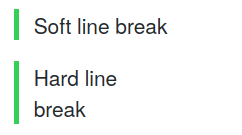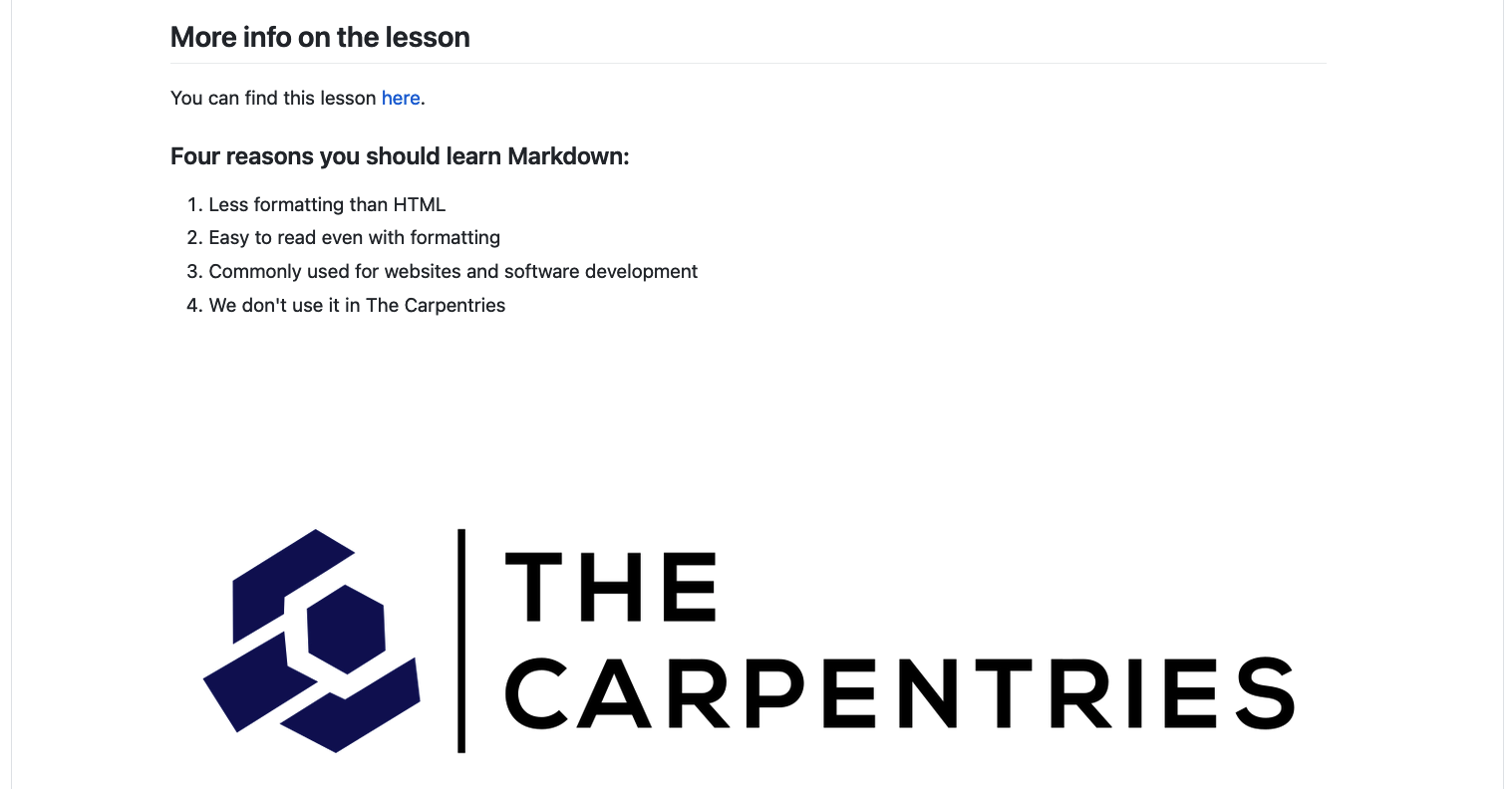Authoring With Markdown
Overview
Teaching: 10 min
Exercises: 15 minQuestions
How can I write content for my webpages?
How do I link to other pages?
Objectives
Create simple pages with formatted text
Markdown
Markdown is a lightweight markup language, i.e. a convention for adding style information to textual content. As the name Markdown indicates, the syntax elements of this language are shut down to a minimum. Having a rather minimalistic syntax, text formatted in Markdown is comparably readable. This might be one reason for Markdown having become the language of choice for formatted user input on websites like, for example:
Where to Start Writing Markdown?
A lot of tools for rendering Markdown source code exist.
Rendering is the process of generating a nice view of the content
using the style information included in the source text.
Chances are high, your editor can do this.
As we are working towards authoring websites using Jekyll and GitHub pages,
we will use GitHub straight away for learning the basics of Markdown.
The GitHub project you created in the last episode contains a file README.md.
The image below shows the projects default view.
This view includes a rendered view of the content inside the file README.md.
Your project should look quite similar except for the red circle around the pencil symbol.
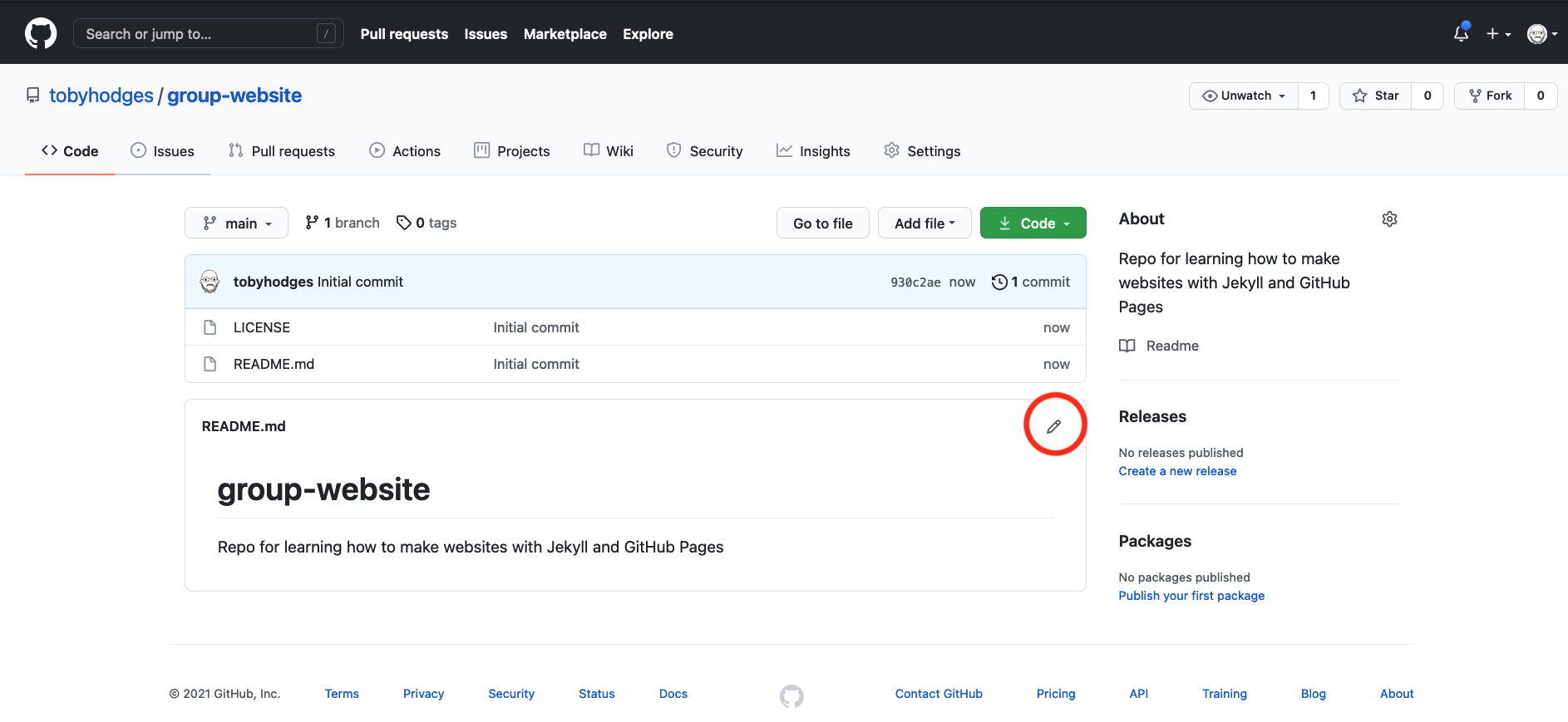
Click on that pencil symbol to open an editing interface of your project’s README.md file.
Once we’ve clicked the pencil symbol, GitHub will open that file in the editing interface.

We can change the content and have a look at the rendered view by clicking the Preview changes tab.

Let’s add Some **bold** font and see what happens when we preview it using the preview tab.
If you check the “Show diff” box on the upper-right hand side, GitHub will show green vertical bars visually highlighting the new content.
To save the content to the file README.md, scroll down a bit and search for a Commit changes menu
at the bottom of the page.
After having changed something, the commit menu looks like this:
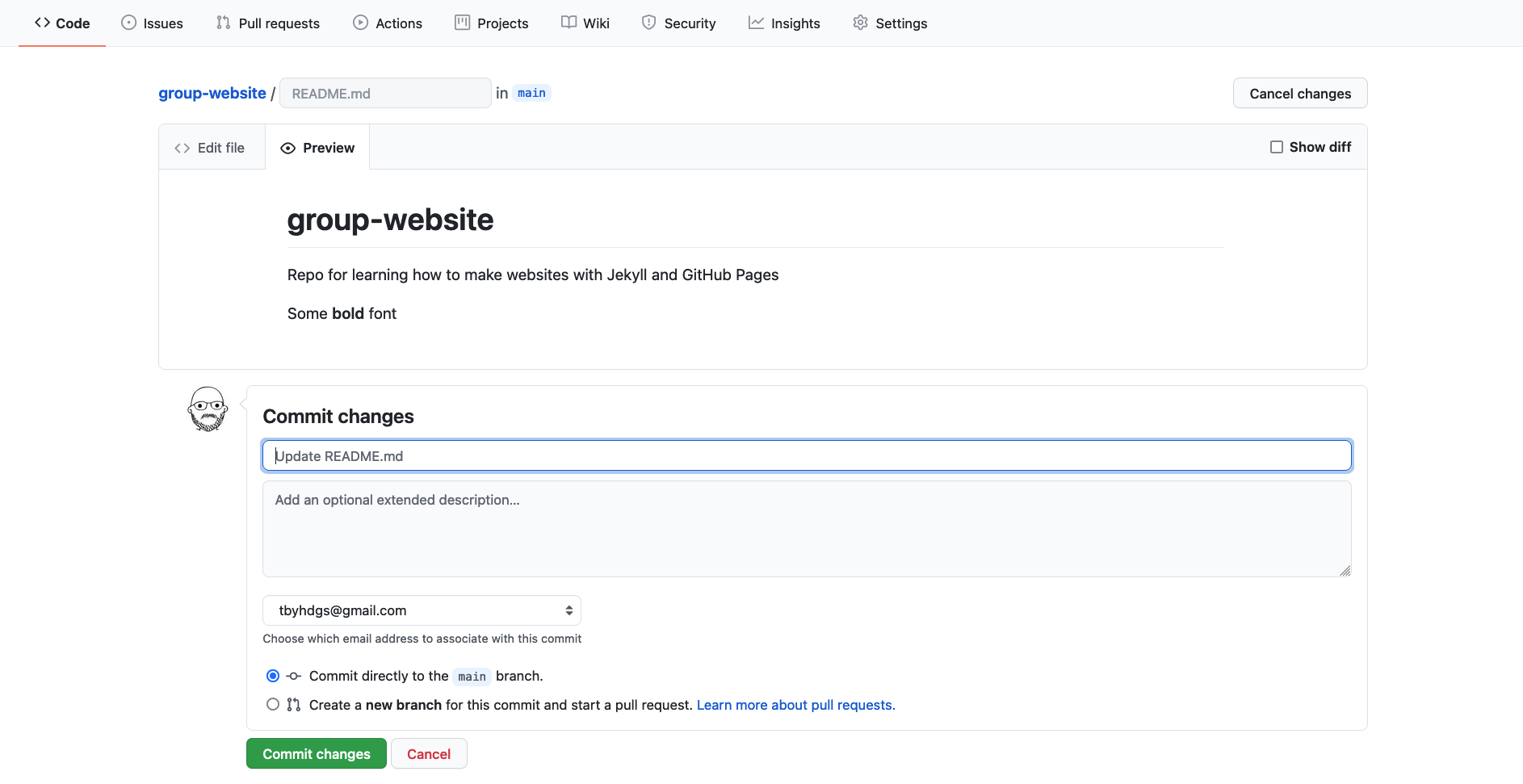
Writing a Commit Message
A commit message is a short, descriptive, and specific comment that will help us remember later on what we did and why. You find more about writing commit message in this section of the Git-novice lesson.
Commit this change to the main branch.
Writing Markdown
Now that we know about the editing interface and preview tab of our projects README.md
we can use it as a text editor and investigate selected Markdown features.
Our README.md already contains vanilla text and
two formatting features:
- Heading
# group-website - Emphasis using
**bold**.
Let’s learn some more Markdown by adding some formatting and see what happens when we preview it using the preview tab.
Add the following to your README.md file.
# group-website
Repo for learning how to make websites with Jekyll pages
## Learning Markdown
Vanilla text may contain *italics* and **bold words**.
This paragraph is separated from the previous one by a blank line.
Line breaks
are caused by two trailing spaces at the end of a line.
[Carpentries Webpage](https://carpentries.org/)
### Carpentries Lesson Programs:
- Software Carpentry
- Data Carpentry
- Library Carpentry
You can then click the preview tab again to see how the formatting renders.
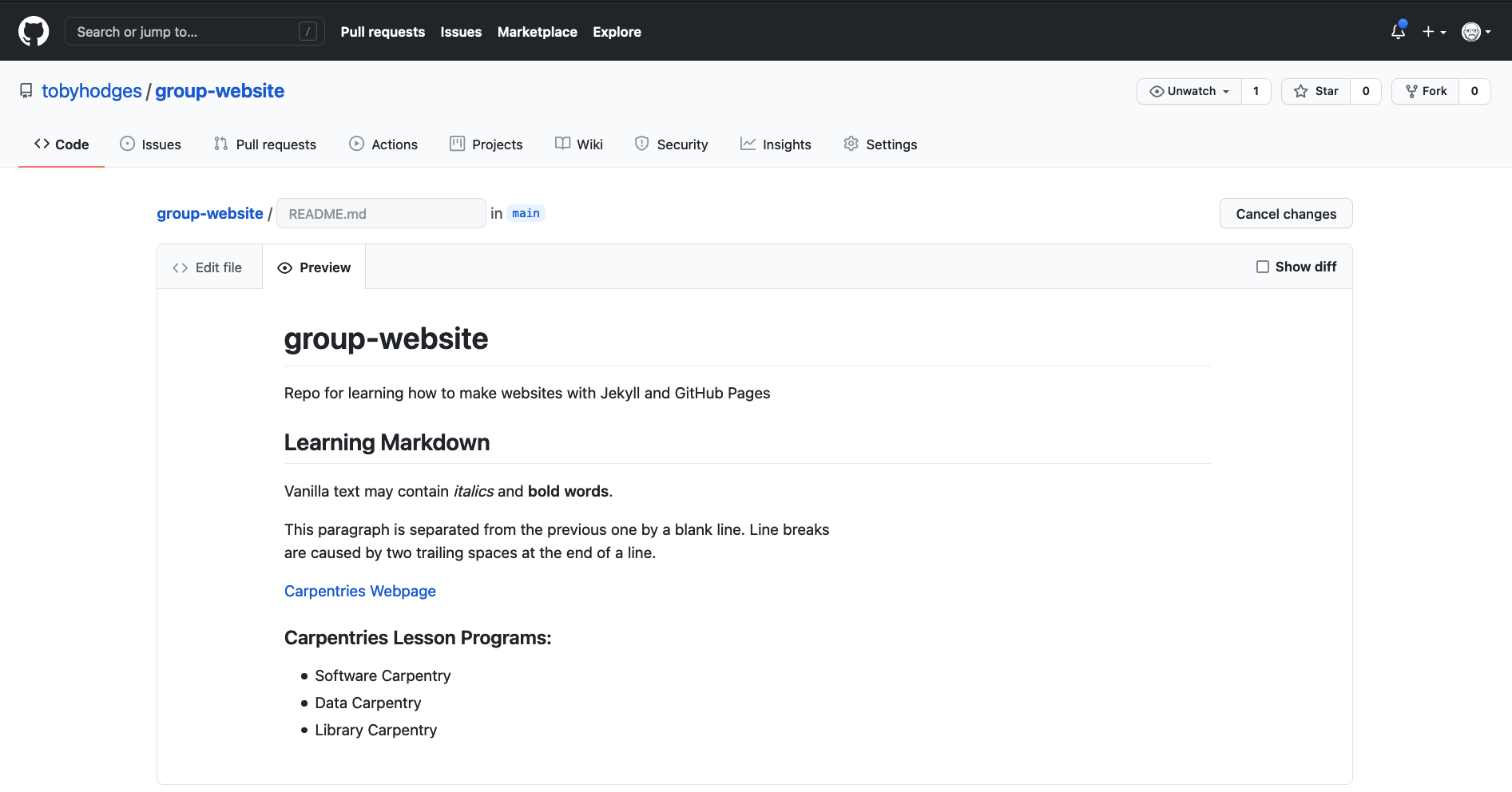
If you click the Show diff checkbox in the right corner, GitHub will include a preview of differences too -
the green bar indicates added lines, the red bar indicates deleted lines, and yellow - lines that have been modified.
Markdown Trailing Spaces Are Meaningful
In the example above there are two spaces at the end of
Line breaks. These introduce what is called a hard line break, causing that paragraph to continue in the next line by adding a<br/>to the generated HTML.If you break the line in a markdown file but don’t include the two trailing spaces the generated HTML will continue in the same line without introducing a
<br/>. This is called a soft line break.In some cases you may find that soft line breaks do introduce a
<br/>. This can happen when using different markdown flavors.See for instance:
Soft line break Hard line breakThat produces:
To keep this addition to our README.md we need to commit these changes to save them.
Scroll down to the bottom of the page, add a commit message if you wish, and then commit to the main branch.
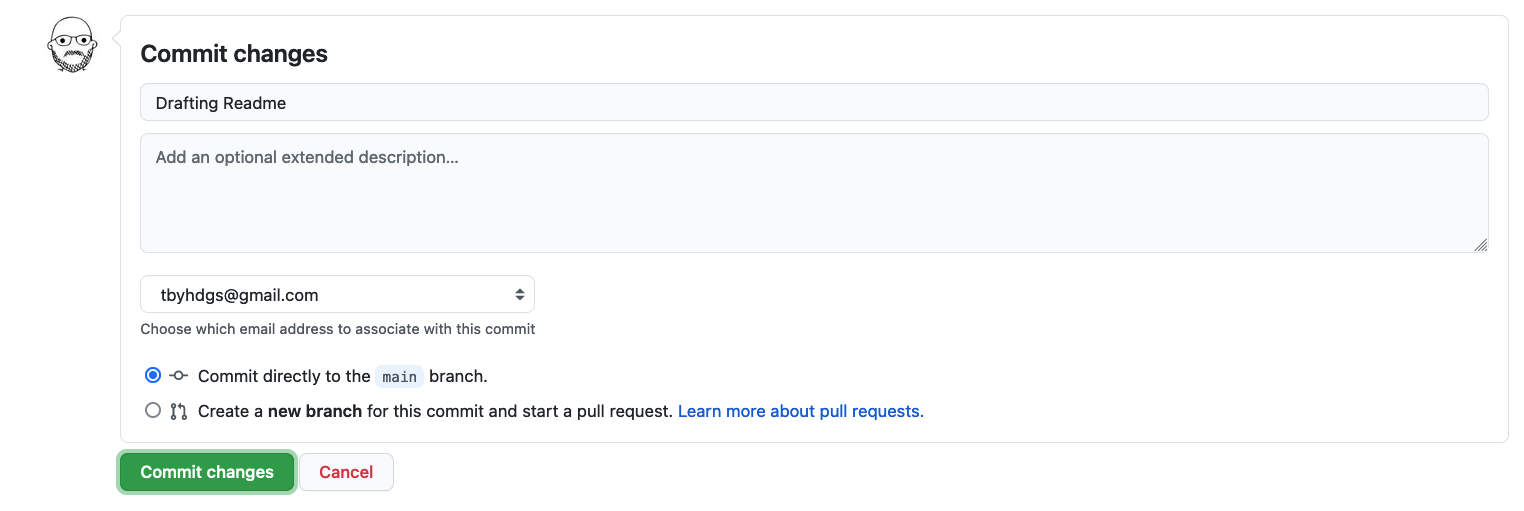
Let’s do an exercise to try out writing more markdown.
Exercise: Try Out Markdown
Use [this cheatsheet][https://www.markdownguide.org/basic-syntax/] to add the following to your
README.md:
- Another second level heading
- Some text under that second level heading that includes an link and
strikethroughtext.- A third level heading
- A numbered list
- Bonus: Add this image https://github.com/carpentries/carpentries.org/blob/main/images/TheCarpentries-opengraph.png
Example Solution
For example your markdown might look like the following:
## More info on the lesson You can find this lesson [here](https://carpentries-incubator.github.io/jekyll-pages-novice/). ### Four reasons you should learn Markdown: 1. Less formatting than HTML 2. Easy to read even with formatting 3. Commonly used for websites and software development 4. We ~~don't~~ use it in The Carpentries 
Reference-Style Links
Up to now, we have used inline-style links which have the URL inline with the description text, for example:
[Carpentries Webpage](https://carpentries.org/)If you use a link more than once, consider using so called reference-style links instead. Reference-style links reference the URL via a label. The label goes into square brackets
[ ]right after the description text of the link and then later, usually at the bottom of the page, you can connect that label to the url it references to complete the link. This looks like:[Carpentries Webpage][carpentries] [carpentries]: https://carpentries.org/and helps to follow the DRY principle, avoiding redundant specification of information.
We will continue to use Markdown and learn more throughout the rest of the lesson. Though later we will find we need HTML again for some features.
Markdown Cheatsheet
Markdown offers a variety of formatting features. Have a look at this cheatsheet to get an overview or look things up.
Markdown Flavours
The initial description of Markdown was informal and contained certain ambiguities so over the years different Markdown implementations and syntax variations (often referred to as “flavours”) appeared to support various syntax features and extensions. As a consequence, the syntax from one variant may not be interpreted as expected in another - you have to be aware which one is being used by a particular platform. Here are a few well-known variants:
- GitHub-flavored Markdown (used on this lesson and by GitHub)
- GitLab-flavored Markdown (used by GitLab)
- Kramdown (a fast, Ruby, open source implementation released under the MIT licence)
More Markdown Features
Check out our Extras page on Markdown for a more comprehensive overview of Markdown, including how to create fenced code blocks and do syntax highlighting for various languages.
Key Points
Markdown is an relatively easy way to write formatted text
